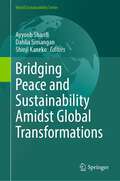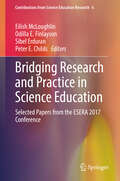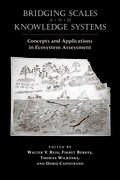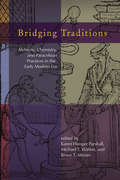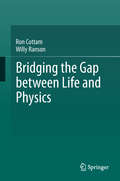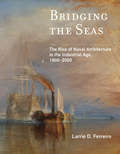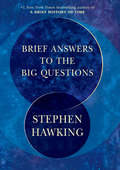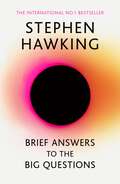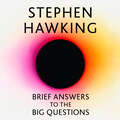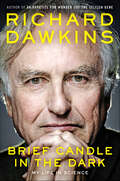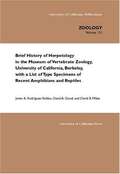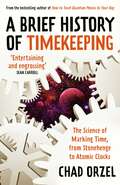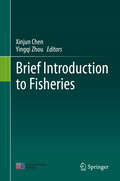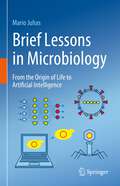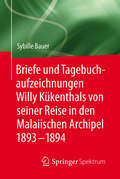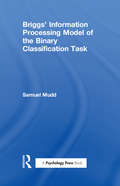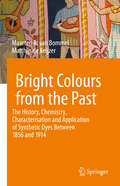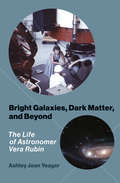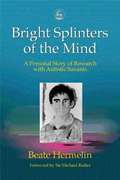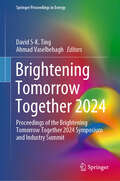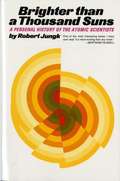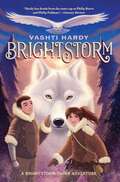- Table View
- List View
Bridging Peace and Sustainability Amidst Global Transformations (World Sustainability Series)
by Shinji Kaneko Ayyoob Sharifi Dahlia SimanganThis book is the sequel to a well-received book titled ‘Integrated Approaches to Peace and Sustainability’ that aims to further advance the understanding of the dynamic interactions between various components of peace and sustainability. How are peace and sustainability linked to each other, and what are the key parameters that define the nexus between them? This book addresses those questions through a combination of theoretical studies and empirical research that contextualize peace and sustainability issues amid global transformations. The conceptual and empirical linkages between peace and sustainability are widely recognized in academic and policy circles. The adoption of the 2030 Agenda for Sustainable Development confirms this recognition. However, many of the initiatives on peace and sustainability operate in silos, undermining the positive and mutually reinforcing relationship between them. Enhanced integration of peace and sustainability components is imperative for addressing complex challenges that come with global transformations that are manifested environmentally, socially, politically, and economically across levels. It is, therefore, crucial to identify the pathways that enhance the peace-promoting potential of sustainability and the sustainability-promoting potential of peace. The contributions in this edited book elaborate on such pathways by offering insights related to different social, economic, and environmental aspects of the peace-sustainability nexus. Given its inter- and trans-disciplinary focus, the book is of interest to policymakers and researchers working in different areas of peace and sustainability. It contributes to ongoing academic and policy discussions surrounding the outcomes of and challenges to achieving the Sustainable Development Goals (SDGs), particularly SDG 16 on peace, justice and strong institutions.
Bridging Research and Practice in Science Education: Selected Papers from the ESERA 2017 Conference (Contributions from Science Education Research #6)
by Sibel Erduran Eilish McLoughlin Odilla E. Finlayson Peter E. ChildsThis edited volume presents innovative current research in the field of Science Education. The chapter’s deal with a wide variety of topics and research approaches, conducted in a range of contexts and settings. Together they make a strong contribution to knowledge on science teaching and learning. The book consists of selected presentations from the 12th European Science Education Research Association (ESERA) Conference, held in Dublin, Ireland from 21st to 25th August, 2017. The ESERA community is made up of professionals with diverse disciplinary backgrounds from natural sciences to social sciences. This diversity enables a rich understanding of cognitive and affective aspects of science teaching and learning. The studies in this book will stimulate discussion and interest in finding new ways of implementing and researching science education for the future. The twenty-two chapters in this book are presented in four parts highlighting innovative approaches to school science, emerging identities in science education, approaches to developing learning and competence progressions, and ways of enhancing science teacher education. This collection of studies showcases current research orientations in science education and is of interest to science teachers, teacher educators and science education researchers around the world with a commitment to bridging research and practice in science teaching and learning.
Bridging Scales and Knowledge Systems: Concepts and Applications in Ecosystem Assessment
by Fikret Berkes Walter Reid Doris Capistrano Walter Millennium Ecosystem Assessment Walter World Resources Institute Thomas WilbanksBridging the gap between local knowledge and western science is essential to understanding the world's ecosystems and the ways in which humans interact with and shape those ecosystems. This book brings together a group of world-class scientists in an unprecedented effort to build a formal framework for linking local and indigenous knowledge with the global scientific enterprise. Contributors explore the challenges, costs, and benefits of bridging scales and knowledge systems in assessment processes and in resource management. Case studies look at a variety of efforts to bridge scales, providing important lessons concerning what has worked, what has not, and the costs and benefits associated with those efforts. Drawing on the groundbreaking work of the Millennium Eco-system Assessment, Bridging Scales and Knowledge Systems will be indispensable for future efforts to conduct ecosystem assessments around the world.
Bridging Traditions: Alchemy, Chemistry, and Paracelsian Practices in the Early Modern Era (Early Modern Studies #15)
by Michael Walton Karen Parshall Bruce MoranBridging Traditions explores the connections between apparently different zones of comprehension and experience—magic and experiment, alchemy and mechanics, practical mathematics and geometrical mysticism, things earthy and heavenly, and especially science and medicine—by focusing on points of intersection among alchemy, chemistry, and Paracelsian medical philosophy. In exploring the varieties of natural knowledge in the early modern era, the authors pay tribute to the work of Allen Debus, whose own endeavors cleared the way for scholars to examine subjects that were once snubbed as suitable only to the refuse heap of the history of science.
Bridging Traditions: Alchemy, Chemistry, and Paracelsian Practices in the Early Modern Era (Early Modern Studies)
by Michael Walton Karen Parshall Bruce MoranBridging Traditions explores the connections between apparently different zones of comprehension and experience—magic and experiment, alchemy and mechanics, practical mathematics and geometrical mysticism, things earthy and heavenly, and especially science and medicine—by focusing on points of intersection among alchemy, chemistry, and Paracelsian medical philosophy. In exploring the varieties of natural knowledge in the early modern era, the authors pay tribute to the work of Allen Debus, whose own endeavors cleared the way for scholars to examine subjects that were once snubbed as suitable only to the refuse heap of the history of science.
Bridging the Gap Between Aristotle’s Science and Ethics
by Henry, Devin and Nielsen, Karen Margrethe Devin Henry Karen Margrethe NielsenThis book consolidates emerging research on Aristotle's science and ethics in order to explore the extent to which the concepts, methods, and practices he developed for scientific inquiry and explanation are used to investigate moral phenomena. Each chapter shows, in a different way, that Aristotle's ethics is much more like a science than it is typically represented. The upshot of this is twofold. First, uncovering the links between Aristotle's science and ethics promises to open up new and innovative directions for research into his moral philosophy. Second, showing why Aristotle thinks ethics can never be fully assimilated to the model of science will help shed new light on his views about the limits of science. The volume thus promises to make a significant contribution to our understanding of the epistemological, metaphysical, and psychological foundations of Aristotle's ethics.
Bridging the Gap between Life and Physics
by Ron Cottam Willy RansonThis is the only book which deals with the correlatory comparison between hierarchical living systems and inorganic physical ones. The culmination of the book is the proposition of research to discover and understand the natural underlying level of organization which produces the descriptive commonality of life and physics. Traditional science eliminates life from its purview by its rejection of interrelationships as a primary content of systems. The conventional procedure of science is that of reductionism, whereby complex systems are dismantled to characterize lower level components, but virtually no attention is given to how to rebuild those systems—the underlying assumption is that analysis and synthesis are symmetrical. This book fulfills two main coupled functions. Firstly, it details hierarchy as the major formulation of natural complex systems and investigates the fundamental character of natural hierarchy as a widely transferable ‘container’ of structure and/or function – and this in the case of the new development of a representational or model hierarchy. Secondly, it couples this hierarchical description to that of the electronic properties of semiconductors, as a well-modeled canonical example of physical properties. The central thesis is that these two descriptions are comparable, if care is taken to treat logical and epistemological aspects with prudence: a large part of the book is composed of just this aspect of care for grounding consistency. As such great attention is given to correct assessment of argumentative features which are otherwise presumed ‘known’ but which are usually left uncertain. Development of the ideas is always based on a relationship between entity or phenomenon and their associated ecosystems, and this applies equally well to the consequent derivations of consciousness and information.
Bridging the Seas: The Rise of Naval Architecture in the Industrial Age, 1800-2000 (Transformations: Studies in the History of Science and Technology)
by Larrie D. FerreiroHow the introduction of steam, iron, and steel required new rules and new ways of thinking for the design and building of ships.In the 1800s, shipbuilding moved from sail and wood to steam, iron, and steel. The competitive pressure to achieve more predictable ocean transportation drove the industrialization of shipbuilding, as shipowners demanded ships that enabled tighter scheduling, improved performance, and safe delivery of cargoes. In Bridging the Seas, naval historian Larrie Ferreiro describes this transformation of shipbuilding, portraying the rise of a professionalized naval architecture as an integral part of the Industrial Age. Picking up where his earlier book, Ships and Science, left off, Ferreiro explains that the introduction of steam, iron, and steel required new rules and new ways of thinking for designing and building ships. The characteristics of performance had to be first measured, then theorized. Ship theory led to the development of quantifiable standards that would ensure the safety and quality required by industry and governments, and this in turn led to the professionalization of naval architecture as an engineering discipline. Ferreiro describes, among other things, the technologies that allowed greater predictability in ship performance; theoretical developments in naval architecture regarding motion, speed and power, propellers, maneuvering, and structural design; the integration of theory into ship design and construction; and the emergence of a laboratory infrastructure for research.
Brief Answers to the Big Questions
by Stephen HawkingThe world-famous cosmologist and #1 bestselling author of A Brief History of Time leaves us with his final thoughts on the biggest questions facing humankind. <P><P>Stephen Hawking was the most renowned scientist since Einstein, known both for his groundbreaking work in physics and cosmology and for his mischievous sense of humor. He educated millions of readers about the origins of the universe and the nature of black holes, and inspired millions more by defying a terrifying early prognosis of ALS, which originally gave him only two years to live. In later life he could communicate only by using a few facial muscles, but he continued to advance his field and serve as a revered voice on social and humanitarian issues. <P><P>Hawking not only unraveled some of the universe’s greatest mysteries but also believed science plays a critical role in fixing problems here on Earth. Now, as we face immense challenges on our planet—including climate change, the threat of nuclear war, and the development of artificial intelligence—he turns his attention to the most urgent issues facing us. Will humanity survive? Should we colonize space? Does God exist? <P><P>These are just a few of the questions Hawking addresses in this wide-ranging, passionately argued final book from one of the greatest minds in history. Featuring a foreword by Eddie Redmayne, who won an Oscar playing Stephen Hawking, an introduction by Nobel Laureate Kip Thorne, and an afterword from Hawking’s daughter, Lucy, Brief Answers to the Big Questions is a brilliant last message to the world. <P><b>A New York Times Bestseller</b>
Brief Answers to the Big Questions: 'A beautiful little book by a brilliant mind' DAILY TELEGRAPH
by Stephen HawkingTHE NO.1 SUNDAY TIMES BESTSELLER'A beautiful little book by a brilliant mind' DAILY TELEGRAPH'Effortlessly instructive, absorbing, up to the minute and - where it matters - witty' GUARDIANThe world-famous cosmologist and #1 bestselling author of A Brief History of Time leaves us with his final thoughts on the universe's biggest questions in this brilliant posthumous work.Is there a God?How did it all begin?Can we predict the future?What is inside a black hole?Is there other intelligent life in the universe?Will artificial intelligence outsmart us?How do we shape the future?Will we survive on Earth?Should we colonise space?Is time travel possible?Throughout his extraordinary career, Stephen Hawking expanded our understanding of the universe and unravelled some of its greatest mysteries. But even as his theoretical work on black holes, imaginary time and multiple histories took his mind to the furthest reaches of space, Hawking always believed that science could also be used to fix the problems on our planet.And now, as we face potentially catastrophic changes here on Earth - from climate change to dwindling natural resources to the threat of artificial super-intelligence - Stephen Hawking turns his attention to the most urgent issues for humankind.Wide-ranging, intellectually stimulating, passionately argued, and infused with his characteristic humour, Brief Answers to the Big Questions, the final book from one of the greatest minds in history, is a personal view on the challenges we face as a human race, and where we, as a planet, are heading next.A percentage of all royalties will go to charity.
Brief Answers to the Big Questions: the final book from Stephen Hawking
by Stephen HawkingRead by Ben Whishaw and Garrick Hagon, with an afterword read by Lucy Hawking. The world-famous cosmologist and #1 bestselling author of A Brief History of Time leaves us with his final thoughts on the universe's biggest questions in this brilliant posthumous work.How did the universe begin? Will humanity survive on Earth? Is there intelligent life beyond our solar system? Could artificial intelligence ever outsmart us?Throughout his extraordinary career, Stephen Hawking expanded our understanding of the universe and unravelled some of its greatest mysteries. But even as his theoretical work on black holes, imaginary time and multiple histories took his mind to the furthest reaches of space, Hawking always believed that science could also be used to fix the problems on our planet.And now, as we face potentially catastrophic changes here on Earth - from climate change to dwindling natural resources to the threat of artificial super-intelligence - Stephen Hawking turns his attention to the most urgent issues for humankind.Wide-ranging, intellectually stimulating, passionately argued, and infused with his characteristic humour, BRIEF ANSWERS TO THE BIG QUESTIONS, the final book from one of the greatest minds in history, is a personal view on the challenges we face as a human race, and where we, as a planet, are heading next.A percentage of all royalties will go to charity.(P)2018 Hodder & Stoughton Limited
Brief Candle in the Dark: My Life in Science
by Richard DawkinsIn this hugely entertaining sequel to the New York Times bestselling memoir An Appetite for Wonder, Richard Dawkins delves deeply into his intellectual life spent kick-starting new conversations about science, culture, and religion and writing yet another of the most audacious and widely read books of the twentieth century—The God Delusion.Called “one of the best nonfiction writers alive today” (Stephen Pinker) and a “prize-fighter” (Nature), Richard Dawkins cheerfully, mischievously, looks back on a lifetime of tireless intellectual adventure and engagement. Exploring the halls of intellectual inquiry and stardom he encountered after the publication of his seminal work, The Selfish Gene; affectionately lampooning the world of academia, publishing, and television; and studding the pages with funny stories about the great men and women he’s known, Dawkins offers a candid look at the events and ideas that encouraged him to shift his attention to the intersection of culture, religion, and science. He also invites the reader to look more closely at the brilliant succession of ten influential books that grew naturally out of his busy life, highlighting the ideas that connect them and excavating their origins.On the publication of his tenth book, the smash hit, The God Delusion, a “resounding trumpet blast for truth” (Matt Ridley), Richard Dawkins was catapulted from mere intellectual stardom into a circle of celebrity thinkers dubbed, “The New Atheists”—including Christopher Hitchens, Sam Harris, and Daniel Dennett.Throughout A Brief Candle in the Dark, Dawkins shares with us his infectious sense of wonder at the natural world, his enjoyment of the absurdities of human interaction, and his bracing awareness of life’s brevity: all of which have made a deep imprint on our culture.
Brief History of Herpetology in the Museum of Vertebrate Zoology, University of California, Berkeley, with a List of Type Specimens of Amphibians and Reptiles
by Javier A. Rodriguez-Robles David A. Good David B. WakeThis monograph offers a brief account of the principal figures associated with the collection and of the most important events in the history of herpetology in the MVZ during its first 93 years, and lists all type specimens of recent amphibians and non-avian reptiles in the collection.
Brief History of Timekeeping: The Science of Marking Time, from Stonehenge to Atomic Clocks
by Chad Orzel&‘Entertaining and engrossing&’ Sean Carroll Press the snooze button on your alarm once too often and you soon remember the importance of good timekeeping. That need to tell the time connects you to over five thousand years of human history, from the first solstice markers at Newgrange to quartz crystal oscillating in your watch today. Science underpins time: measuring the movement of Sun, Earth and Moon, and unlocking the mysteries of quantum mechanics and relativity theory – the key to ultra-precise atomic clocks. Yet time is also socially decided: the Gregorian calendar we use today came out of fraught politics, while the ancient Maya used sophisticated astronomical observations to produce a calendar system unlike any other. In his quirky and accessible style, Chad Orzel reveals the wondrous physics that makes time something we can set, measure and know.
Brief Introduction to Fisheries
by Xinjun Chen Yingqi ZhouThis book offers an introduction to aquaculture sciences and fisheries, discussing the concepts and basic characteristics of fisheries, fishery resources and the related industries, as well as the status of fisheries in various countries around the globe. The book also examines aquaculture, aquatic product processing and utilization, fishery information technology, and fishery economics and management, in addition to hot topics such as blue growth in fisheries, carbon sink fisheries, and global environmental changes in the context of fisheries. Given its scope, it is a valuable resource for undergraduate students in the field as well professional requiring a basic understanding of fisheries.
Brief Lessons in Microbiology: From the Origin of Life to Artificial Intelligence
by Mario JuhasRecent discoveries in microbiology are hard to grasp for those unfamiliar with scientific jargon, and the research data can be overwhelming even for those working in other scientific fields. This book aims to remedy this situation by presenting the most interesting findings and current trends in microbiology in an easy-to-read and understandable format. The first part tells the story of the beginnings of microbiology itself and introduces the reader to the founders of this fascinating research discipline. The second part focuses on communication between microorganisms and how they organize themselves into fascinating microbial cities called “biofilms”. The reader also learns how bacteria exchange genetic material - mechanisms that are the root of the emergence of multidrug-resistant superbugs, pathogens that pose a major burden to human health and our healthcare systems. The third part is devoted to the latest techniques being used by scientists to study, control, and manipulate microorganisms for our benefit. The final part links the first three parts together and highlights how infectious diseases, including coronaviruses, can be transmitted from animals to humans, how global warming is affecting emerging diseases, and provides information on the actions that need to be taken to get ahead of pathogenic microbes and future pandemics. This comprehensive, state-of-the-art book is intended for anyone interested in microbiology and epidemiology, from biology and biomedical students in schools and colleges, to patients suffering from infectious diseases who want to learn more about their condition. The concepts covered in this book contribute to UN Sustainable Development Goal 3: Health and Well-Being.
Briefe und Tagebuchaufzeichnungen Willy Kükenthals von seiner Reise in den Malaiischen Archipel 1893–1894
by Sybille BauerIn diesem Buch finden Sie die von Willy Kükenthal, dem berühmten deutschen Zoologen und Forschungsreisenden, erhaltenen Briefe, die er während seiner Reise in den Malaiischen Archipel Ende des 19. Jahrhunderts an seine Frau geschrieben hat und ein auf Borneo geführtes wissenschaftliches Tagebuch. Giftmischende Malayen auf Halmahera, kopfjagende Alfuren in Borneo, Fiebersümpfe, Moskitoschwärme und Blutegel – über fast alles hat er seine Frau, wenn auch oft diplomatisch, in Kenntnis gesetzt. Die Methoden der Penisperforation jedoch vertraute er nur seinem Tagebuch. an. Die Dokumente seiner Reise geben einen Einblick in die Erfahrungen, die Willy Kükenthal während seiner Abenteuer in Südostasien gemacht hat. Sie sind ein eindrucksvolles Zeugnis der Forschung im 19. Jahrhundert. Die Briefe und das Tagebuch zeigen, unter welch extremen Bedingungen Zoologen aus Kükenthals Generation forschten, um Sammlungen für Museen zusammenzustellten.
Briggs' Information Processing Model of the Binary Classification Task
by S. MuddFirst published in 1983. Routledge is an imprint of Taylor & Francis, an informa company. This monograph is a review of the evolution of George Briggs’ informationprocessing model from a general schema beginning with the work of Saul Sternberg (1969a) and Edward E. Smith (1968) to a fairly well-detailed schematic representation of central processes that Briggs was working on at the time of his early death. The development of Briggs’ model of the binary classification task (BCT) spanned the period from 1969 when he published his first report on choice reaction time with Blaha (Briggs & Blaha, 1969) to 1977 with the publication of a posthumous paper (Briggs, Thomason, & Hagman, 1978). The model evolved across a total of 16 experimental and 2 review papers.
Bright Colours from the Past: The History, Chemistry, Characterisation and Application of Synthetic Dyes Between 1856 and 1914 (Cultural Heritage Science)
by Matthijs de Keijzer Maarten R. van BommelThe invention of Mauveine by Perkin in 1856 led to a revolution in the world of textile dyeing. In the second half of the 19th century, natural dyes were quickly replaced by newly developed synthetic dyes which resulted in a bright palette of colours. The synthetic dyes were not only cheaper to produce, but also easier to apply on textiles due to new dyeing mechanisms. As a result, production costs decreased tremendously and brilliantly dyed textiles became available to the larger public. The introduction of synthetic dyes had a strong impact in fashion; in addition, these colourants were also used as stains on furniture, as inks and in paints. In this publication, the development of these vivid colourants is presented. It brings together information about the history of synthetic dyes, including the first attempts, the so-called semi-synthetic dyes, and presenting the most relevant dyes and dye classes, such as nitro dyes, tri-arylmethanes, azo dyes, xanthenes, sulfur dyes, synthetic alizarin and synthetic indigo. It contains a wealth of information regarding the numerous synonyms, trade names, manufacturers and patents. International trade and competition, which was fierce, are discussed. The chemistry behind the synthetic dyeing is explained, including new dyeing technologies developed. The application of dyes and their fastness properties are also presented. An overview of analytical techniques used for characterisation is given. Many case studies are included, expressing the importance of the dyes and the creativity of mankind when applying these colourants. As such, this publication can be seen as a colourful journey through history, relevant for conservators, curators, historians, chemists and all who are interested in the history and development of synthetic dyes.
Bright Dreams: The Brilliant Inventions of Nikola Tesla
by Tracy DockrayYoung Nikola Tesla got a shock when he rubbed his cat's fur. That small spark lit his imagination forever. Covering his early years to his eventual success in the world of electricity, Bright Dreams showcases Tesla's incredible journey of discovery and perseverance. Author-illustrator Tracy Dockray conveys Tesla's busy and imaginative world with collage-style artwork and informative sidebars.
Bright Galaxies, Dark Matter, and Beyond: The Life of Astronomer Vera Rubin
by Ashley Jean YeagerHow Vera Rubin convinced the scientific community that dark matter might exist, persevering despite early dismissals of her work. We now know that the universe is mostly dark, made up of particles and forces that are undetectable even by our most powerful telescopes. The discovery of the possible existence of dark matter and dark energy signaled a Copernican-like revolution in astronomy: not only are we not the center of the universe, neither is the stuff of which we&’re made. Astronomer Vera Rubin (1928–2016) played a pivotal role in this discovery. By showing that some astronomical objects seem to defy gravity&’s grip, Rubin helped convince the scientific community of the possibility of dark matter. In Bright Galaxies, Dark Matter, and Beyond, Ashley Jean Yeager tells the story of Rubin&’s life and work, recounting her persistence despite early dismissals of her work and widespread sexism in science. Yeager describes Rubin&’s childhood fascination with stars, her education at Vassar and Cornell, and her marriage to a fellow scientist. At first, Rubin wasn&’t taken seriously; she was a rarity, a woman in science, and her findings seemed almost incredible. Some observatories in midcentury America restricted women from using their large telescopes; Rubin was unable to collect her own data until a decade after she had earned her PhD. Still, she continued her groundbreaking work, driving a scientific revolution. She received the National Medal of Science in 1993, but never the Nobel Prize—perhaps overlooked because of her gender. She&’s since been memorialized with a ridge on Mars, an asteroid, a galaxy, and most recently, the Vera C. Rubin Observatory—the first national observatory named after a woman.
Bright Splinters of the Mind: A Personal story of research with Autistic Savants
by Beate HermelinThe author describes a series of studies which she and her colleagues have conducted in an attempt to gain a deeper understanding of autistic savant syndrome. Her subjects include children and adults with autism who have remarkable abilities in music, art, mathematics, foreign languages, and calendar calculation. Hermelin suggests that people with autism perceive detail before recognizing an integrated whole. This is a very readable book with a strong scholarly foundation.
Brightening Tomorrow Together 2024: Proceedings of the Brightening Tomorrow Together 2024 Symposium and Industry Summit (Springer Proceedings in Energy)
by David S-K. Ting Ahmad VaselbehaghThis book includes the proceedings of the Symposium and Industry Summit, June 20-21, 2024 at University of Windsor Negativity and pessimism seem to dominate the media in recent years, overshadowing the bright side of our beautiful planet and disheartening its inhabitants. Not to deny the prevailing challenges, but tomorrow is far from complete ruin and doom. Brightening Tomorrow Together aims at bringing optimists from many disciplines of expertise and walks of life together to synergise existing know-how and further the latest technologies and measures to hasten the brightening of tomorrow. This book is part of the big dream of the Turbulence and Energy Laboratory. It strives to bring together a diverse group to exchange state-of-the-art progresses and to promote collaborations across different disciplines to hasten the brightening of tomorrow together. Topics of interest include engineering cleaner energy, improving our understandings of water and wastewater, reducing waste and pollution at all fronts, and actualizing eco-friendly agriculture and living.
Brighter Than a Thousand Suns: A Personal History of the Atomic Scientists
by Robert Jungk James CleughAn account of the remarkable scientists who discovered that nuclear fission was possible and then became concerned about its implications. Index. Translated by James Cleugh.
Brightstorm: A Sky-ship Adventure (Brightstorm #1)
by Vashti HardyCritically acclaimed in the UK, Brightstorm is a fast-paced fantasy adventure novel that will set imaginations soaring. Arthur and Maudie Brightstorm receive devastating news: their famous explorer father has died in a failed attempt to reach South Polaris. To make matters worse, the Lontown Geographical Society finds Ernest Brightstorm guilty of sabotaging the expedition of his competitor, Eudora Vane. But a mysterious clue leads the twins to question the story they’ve been told—and to uncover the truth, they must undertake the journey of a lifetime. Joining the ragtag crew of a homemade sky-ship captained by the intrepid Harriet Culpepper, Arthur and Maudie race to South Polaris to salvage their family’s reputation and find out what really happened on their father’s doomed expedition. Brightstorm is a propulsive and compelling fantasy adventure set among the vibrant landscapes and dynamic characters of Vashti Hardy’s vividly imagined world.
